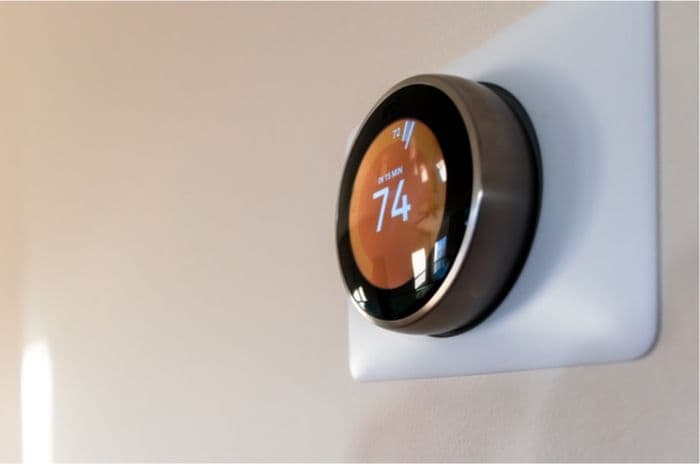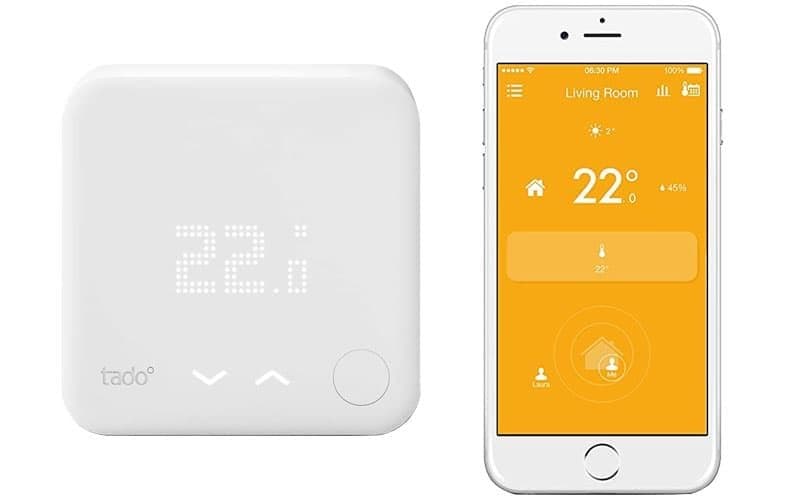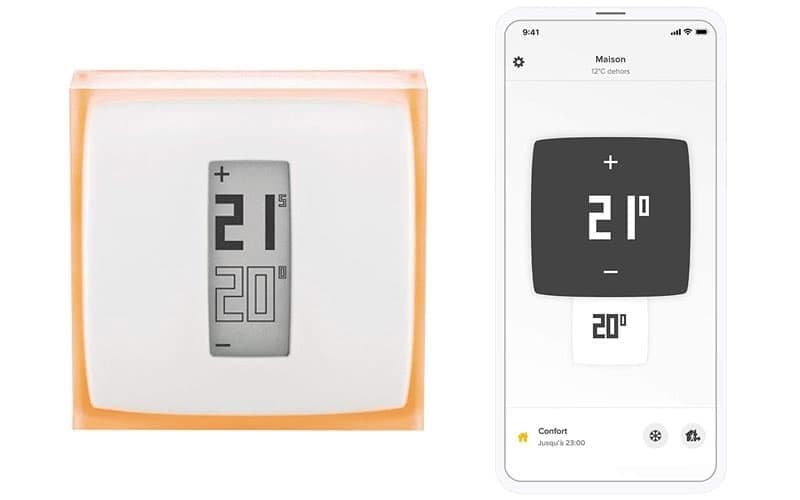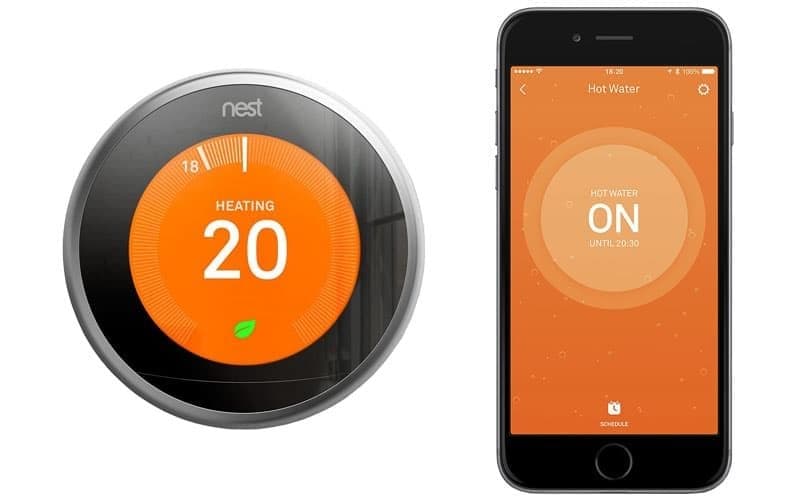Smart thermostats still carry out the core function of switching on the heating when the temperature drops, but they can learn to do so only when there's somebody home to appreciate it.
Aside from the extra control they give you, smart thermostats can save you money - an important consideration given that heating tends to be our largest household bill.
In this guide, we look at some of the best available smart thermostats in 2020, including:

At a glance
| Google Nest Learning Thermostat | Hive Active Heating 2 | Netatmo Thermostat | Honeywell Home T6R | Tado Smart Thermostat | |
|---|---|---|---|---|---|
| Price | £170 | £180 | £135 | £200 | £180 |
| Motion sensor | Yes | No | No | No | No |
| GPS tracking | Yes | Yes | No | Yes | Yes |
| Child lock | Yes | Yes | Yes | No | No |
| Weather responsive | No | No | No | Yes | Yes |
| Installation | Professional recommended | Professional recommended | Self or professional | Professional recommended | Self or professional |
| Dimensions (HxWxD) | 84 x 84 x 33mm | 100 x 100 x 49mm | 83 x 83 x 25mm | 103 x 103 x 68mm | 104 x 104 x 18mm |
Price
Winner: The Tado smart thermostat is the cheapest device and comes with a money-back guarantee.

A good quality smart thermostat costs somewhere between £100 and £250. Those at the cheaper end tend to have less features and a more basic design than their more expensive counterparts.
Of the devices we looked at, the Google Nest is the most expensive at up to £200 depending on colour choice. This is followed by the Hive Active Heating, the Netatmo and the Honeywell Home T6R all at around £140, and the Tado at £130.
For those looking to save money quickly, the Tado is notable for offering customers a full refund if they haven't saved enough during the first year.
Installation
Winner: While the Netatmo isn't the cheapest to buy outright, the possibility of fitting it yourself makes it good value overall.

You need to factor in the cost of installation when choosing a smart thermostat, as most devices require a professional engineer to fit them. This can bump up the overall cost by £100.
There are some exceptions however. The Netatmo smart thermostat doesn't need mains power, so you don't need to have electrical knowledge to fit it. There are clear diagrams for each stage of installation, making it a realistic project for almost anyone.
The Tado is also billed as being a DIY device, though it does require hooking up to the mains. This means you'll need some experience of wiring. If in doubt, leave it to a professional.
App quality
Winner: The best app isn't the one with the most features - it's the one that makes it easy to find the features you want. In this respect, the Netatmo is the winner, with most of the functions you need found on the main screen.
All of the smart thermostats have an associated app. Most people use the app to control the thermostat, rather than fiddling with the device itself.
While some of the apps are simple, others can be slightly overwhelming.
The Google Nest Learning app falls into the latter category. It's well designed and easy to navigate, but the sheer number of settings is difficult to get a handle on.
It's also not that easy to program yourself - primarily because it's designed to work automatically by 'learning' your behavioural patterns.
The Hive Active Heating app feels a little overcomplicated too. The design itself is simple, but the number of available tabs and options seem excessive.
The Tado app is far easier to use - programing a schedule is straightforward and the other features can be accessed intuitively.
The Honeywell app is similarly user-friendly, with each tab having an obvious function.
The Netatmo app works really well, and is the easiest of the lot to set up. The interface is clean and it's easy to navigate.
Features
Winner: The Google Nest Learning has a great range of features and the all-important ability to learn. If you're a creature of habit, then you'll quickly be provided with optimal heating without having to lift a finger.

Using GPS, some can tell when you're not at home and turn the heating down. They might also turn it on when they detect that you're on your way back.
Others can adjust the heating based on the weather outside, or alter the temperature of individual rooms (when used in conjunction with smart thermostatic radiator valves).
If you're already running a voice assistant like Alexa or Google Assistant in your home, you can integrate your smart thermostat with it and control your heating via voice commands.
All of the smart thermostats share some basic attributes, such as the ability to set a heating schedule and control the heating when you're away from home.
There are some important differences though - like the ability to learn or detect whether anyone's at home.
Geofencing
This refers to the ability of a device to respond when a mobile device enters or leaves a certain area.
In the case of smart thermostats, it means that the heating can be turned on or off depending on whether your mobile is approaching your home or moving away from it.
The only smart thermostat without geofencing is the Netatmo.
Motion sensor
The Google Nest Learning has a built-in motion sensor enabling it to make an informed decision as to whether anybody is at home..
This is a handy feature if you have guests as it means the heating won't go off if they're in the house by themselves.
Child lock
A new device appearing in the house is a magnet for small fingers. With this in mind, some smart thermostats can be locked to prevent their being tampered with.
The Google Nest Learning, the Hive Active and the Netatmo all have a child lock feature.
Learning
Some smart thermostats - primarily the Google Nest - are able to learn your routines and change the heating accordingly. So, for example, if you regularly go to bed at 10pm, the thermostat will learn to turnt the heating off at that time.
The Netatmo also has learning capabilities. For example, it can calculate when to turn the heating on based on your home's level of insulation and the outside temperature.
While not specifically a learning device, the Tado responds to the temperature outside and the weather forecast to set the temperature inside.
Aesthetics
Winner: The Google Nest Learning smart thermostat has a simple, but eminently pleasing design. The stainless steel surround suggests quality, and the display held within is elegantly minimalist.
You should be happy with the appearance of your smart thermostat, as it's going to be on display for all to see.
Designs vary in both display and casing. For example, the stainless steel Google Nest device resembles a dial from a Victorian steamship - albeit, a futuristic one.
By contrast, the Netatmo is a simple white box (though you can change the edging to one of four colours) with a simple digital display.
The Honeywell device is similarly basic, with a grey bezel that isn't particularly attractive.
The Tado smart thermostat is another white box, but its display has a retro feel, being made up of points of light like an old illuminated billboard.
The Hive Active Heating 2 has the busiest display, but portrays an overall impression of sleekness. In essence, it resembles a dimmer light switch with a screen.
Voice control
Winner: The Netatmo, Honeywell and Tado all offer equally good connectivity with voice assistants.
Those of you who already use a voice assistant in your home will want to make sure that your chosen smart thermostat is compatible with it.
The Google Nest and Hive Active Heating devices don't work with Apple HomeKit, for example.
If you haven't yet decided whether to go with Google, Siri or Alexa, it's best to hedge your bets and opt for the device with the greatest range of connectivity options.
| Nest Learning Thermostat | Hive Active Heating 2 | Netatmo Thermostat | Honeywell Lyric T6R | Tado Smart Thermostat | |
|---|---|---|---|---|---|
| Apple HomeKit | No | No | Yes | Yes | Yes |
| Google Home | Yes | Yes | Yes | Yes | Yes |
| Amazon Alexa | Yes | Yes | Yes | Yes | Yes |
| IFTTT | Yes | Yes | Yes | Yes | Yes |
Our verdict
It's a close call between the Google Nest Learning thermostat and the Netatmo, but on balance we'd tend to go with the Netatmo.
| Google Nest Learning Thermostat | £170 | Amazon.co.uk |
|---|---|---|
| Hive Active Heating 2 | £180 | Amazon.co.uk |
| Netatmo Thermostat | £135 | Amazon.co.uk |
| Honeywell Home T6R | £200 | Amazon.co.uk |
| Tado Smart Thermostat | £180 | Amazon.co.uk |
Why? For one, you can install it yourself, which makes its £140 price tag seem relatively modest.
Its app is well designed and accessible to novice users, as well as providing more advanced options for those with more specific heating requirements.
It has some ability to learn, as well as some novel time-saving features. For example, it asks you when you get up, leave for work, return home and go to bed, and produces a heating schedule based on the answers.
While the Netatmo may not have the good looks of the Google Nest or Hive Active Heating, it's still a good all-round option for those looking for their first smart thermostat.









Comments (1)